| Listing 1 - 10 of 147 | << page >> |
Sort by
|
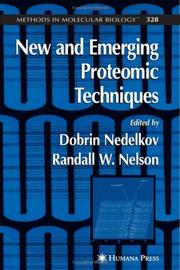
ISBN: 1280832924 9786610832927 159745026X 1588295192 Year: 2006 Publisher: Totowa, NJ : Humana Press : Imprint: Humana,
Abstract | Keywords | Export | Availability | Bookmark
 Loading...
Loading...Choose an application
- Reference Manager
- EndNote
- RefWorks (Direct export to RefWorks)
Numerous emerging technologies have propelled the growth of proteomics into a wide-ranging discipline with great potential to improve human health through the discovery of new protein biomarkers and therapeutics. In New and Emerging Proteomic Techniques, a panel of leading researchers and innovators describe in step-by-step detail the latest techniques that promise to significantly impact the practice of proteomics, as well as its success in developing novel clinical agents. The methods described here span the entire spectrum of top-down and bottom-up approaches, including microarrays, gels, chromatography, and affinity separations, and address every aspect of the human proteome, both quantitatively and qualitatively. The techniques of protein detection utilized are diverse and range from fluorescence and resonance light scattering to surface plasmon resonance and mass spectrometry. Where necessary, two or more distinct techniques are provided for a given problem, and advanced bioinformatics approaches are presented for the analysis of complex proteomic data. The protocols follow the successful Methods in Molecular Biology™ series format, each offering step-by-step laboratory instructions, an introduction outlining the principles behind the technique, lists of the necessary equipment and reagents, and tips on troubleshooting and avoiding known pitfalls. Comprehensive and easy to use, New and Emerging Proteomic Techniques offers expert and novice investigators alike today's most promising proteomics techniques for probing the biological processes and understanding the diseases of the human body.
Biochemistry. --- Biochemistry, general. --- Biological chemistry --- Chemical composition of organisms --- Organisms --- Physiological chemistry --- Biology --- Chemistry --- Medical sciences --- Composition
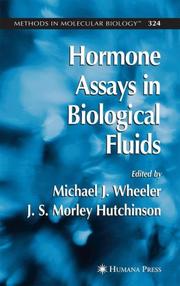
ISBN: 128035867X 9786610358670 1592599869 1588290050 Year: 2006 Publisher: Totowa, NJ : Humana Press : Imprint: Humana,
Abstract | Keywords | Export | Availability | Bookmark
 Loading...
Loading...Choose an application
- Reference Manager
- EndNote
- RefWorks (Direct export to RefWorks)
Although automated systems can measure all common hormones in human blood, they are expensive and often incapable of measuring hormones in urine, saliva, and animals. In Hormone Assays in Biological Fluids, expert researchers who have developed and applied significant new assays describe in step-by-step detail readily reproducible methods for measuring a broad variety of hormones, related peptides, and synthetic steroids in various biological fluids. The hormones measured range from glucocorticoids in biological fluids, urinary steroids, aldosterone in blood, and plasma renin activity, to gut hormones in plasma, melatonin, prolactin, 6-sulfatoxymelatonin, and androgens in blood, saliva, and hair. The emphasis is on noncommercial assays so that investigators can develop novel methods suited to their special needs. Commercial assays are also described for comparative purposes. Tutorials on radioimmunoassay, gas chromatography-mass spectrometry, high-performance liquid chromatography, and polymerase chain reaction techniques help readers choose the best methods for their purpose. The protocols follow the successful Methods in Molecular Medicine™ series format, each offering step-by-step laboratory instructions, an introduction outlining the principles behind the technique, lists of the necessary equipment and reagents, and tips on troubleshooting and avoiding known pitfalls. Wide-ranging and highly practical, Hormone Assays in Biological Fluids illuminates the many different methods available for a broad range of hormone assays, enabling researchers to choose the optimal existing methods or develop novel assays for their specialized purposes.
Biochemistry. --- Biochemistry, general. --- Biological chemistry --- Chemical composition of organisms --- Organisms --- Physiological chemistry --- Biology --- Chemistry --- Medical sciences --- Composition
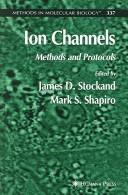
ISBN: 1280832169 9786610832163 1597450952 1588295761 Year: 2006 Publisher: Totowa, NJ : Humana Press : Imprint: Humana,
Abstract | Keywords | Export | Availability | Bookmark
 Loading...
Loading...Choose an application
- Reference Manager
- EndNote
- RefWorks (Direct export to RefWorks)
It is now clear that ion channels play essential roles in cell biology and physiology and that their dysfunction is the root cause of many human diseases. In Ion Channels: Methods and Protocols, internationally recognized biomedical scientists describe recent technological breakthroughs and demonstrate their use in successful experimental designs. The diverse applications range from the study of allosteric regulation of ion channel activity using a classic mutagenesis approach, to the study of channel subunit stoichiometry using a novel biophysical approach based on fluorescence resonance energy transfer. Highlights include methods for heterologous expression of ion channels in cells, for determining channel structure-function, for studying channel regulation and physiological function, and for genetic screening and investigating channelopathies. The protocols follow the successful Methods in Molecular Biology™ series format, each offering step-by-step laboratory instructions, an introduction outlining the principles behind the technique, lists of the necessary equipment and reagents, and tips on troubleshooting and avoiding known pitfalls. Comprehensive and highly practical, Ion Channels: Methods and Protocols offer both novice and experienced researchers a versatile collection of proven techniques for illuminating the structure, function, and regulation of ion channel proteins and finding suitable drug targets when they cause disease.
Biochemistry. --- Biochemistry, general. --- Biological chemistry --- Chemical composition of organisms --- Organisms --- Physiological chemistry --- Biology --- Chemistry --- Medical sciences --- Composition
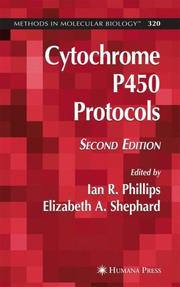
ISBN: 1280358629 9786610358625 1592599982 1588294412 Year: 2006 Publisher: Totowa, NJ : Humana Press : Imprint: Humana,
Abstract | Keywords | Export | Availability | Bookmark
 Loading...
Loading...Choose an application
- Reference Manager
- EndNote
- RefWorks (Direct export to RefWorks)
For this second edition of their much praised Cytochrome P450, the editors have collected accounts of the essential core techniques that use the latest methodologies for the investigation of P450s. Highlights include protocols for spectral analysis and purification of P450s, enzymatic assays of P450s and flavin-containing monooxygenases (FMOs), expression of P450s and FMOs in heterologous systems, and the production and use of antipeptide antibodies. Additional chapters contain readily reproducible techniques for the transfection of hepatocytes for gene regulation studies, P450 reporter gene assays, in situ hybridization, and analysis of genetic polymorphisms. Also described are techniques for the generation of mice with targeted gene disruptions. Although the emphasis is on P450s of mammalian origin, many of the readily reproducible methods described are suitable for P450s from any source. Each chapter is written by researchers who have been involved in the development and application of the particular technique to P450s or FMOs. The protocols are presented in a step-by-step manner, with extensive cross-references to notes that highlight critical steps, potential problems, and alternative methods so that the researcher can understand the basis of the method and perform it successfully. Cutting-edge and highly practical, Cytochrome P450, Second Edition provides both novices and experienced researchers across many fields all the tools needed today to elucidate the crucial biological role played by cytochrome P450 in the metabolism of therapeutic drugs, chemical carcinogens, and environmental pollutants.
Biochemistry. --- Biochemistry, general. --- Biological chemistry --- Chemical composition of organisms --- Organisms --- Physiological chemistry --- Biology --- Chemistry --- Medical sciences --- Composition
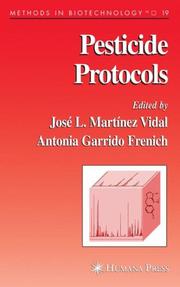
ISBN: 1588294102 9786610358113 1280358114 159259929X Year: 2006 Publisher: Totowa, NJ : Humana Press : Imprint: Humana,
Abstract | Keywords | Export | Availability | Bookmark
 Loading...
Loading...Choose an application
- Reference Manager
- EndNote
- RefWorks (Direct export to RefWorks)
Recent advances in the analysis of pesticide residues in both environmental and food commodities hold out the possibility of analyzing many pesticides in one analytical run. In Pesticide Protocols, expert researchers-who have each perfected the techniques they write about-describe in step-by-step detail robust methods for the detection of pesticide compounds or their metabolites, techniques that are highly useful in food, environmental, and biological monitoring, and in studies of exposure via food, water, air, and the skin or lungs. The methods range from gas and liquid chromatography coupled to mass spectrometry detection and other classic detectors, to capillary electrophoresis and immunochemical or radioimmunoassay techniques. The authors apply these broad-ranging techniques to the analysis of several families of pesticides, to pesticide residues in vegetables, to pesticides in water and air, and to pesticide exposure. The authors have focused on extraction and cleanup procedures in order to develop and optimize more fully automated and miniaturized methods, including solid-phase extraction, solid-phase microextraction, microwave-assisted extraction, and on-line tandem liquid chromatography trace enrichment, among others. The protocols follow the successful Methods in Biotechnology™ series format, each offering step-by-step laboratory instructions, an introduction outlining the principles behind the technique, lists of the necessary equipment and reagents, and tips on troubleshooting and avoiding known pitfalls. Comprehensive and versatile, Pesticide Protocols offers analysts powerful and highly practical tools for analyzing the presence of pesticides in complex matrices.
Biochemistry. --- Biochemistry, general. --- Biological chemistry --- Chemical composition of organisms --- Organisms --- Physiological chemistry --- Biology --- Chemistry --- Medical sciences --- Composition
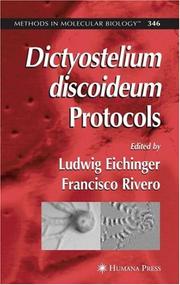
ISBN: 1280832347 9786610832347 1597451444 1588296237 Year: 2006 Publisher: Totowa, NJ : Humana Press : Imprint: Humana,
Abstract | Keywords | Export | Availability | Bookmark
 Loading...
Loading...Choose an application
- Reference Manager
- EndNote
- RefWorks (Direct export to RefWorks)
Dictyostelium discoideum Protocols presents a comprehensive collection of cutting-edge molecular biological protocols for studying D. discoideum, with emphasis on its utility in the study of fundamental cellular processes including signal transduction, chemotaxis, cell motility, cytokinesis, phagocytosis, and aspects of development such as cell sorting, pattern formation, and cell type differentiation. Written by experts in the field, this important guide provides easy access to current methods and techniques for the study of D. discoideum. For the newcomer to the field, it offers a complete and inclusive introduction to this important model organism. The book is divided into four main parts, which include an introduction to the organism that provides integral community resources and genome-wide approaches; basic methods and available molecular genetic techniques for study of the organism; imaging and localization methods; and a discussion of D. discoideum, with emphasis on its unique advantages as a model system. This in-depth guide provides a complete introduction to and thorough handbook for the study of D. discoideum, including a discussion of the implications of the recently completed Dictyostelium genome project in strengthening the position of D. discoideum as a model organism for studying fundamental cell processes and aspects of development. Researchers at all levels of experience will benefit from the presentations throughout of the most current, useful, and innovative techniques for the study of D. discoideum from leading Dictyostelium scientists.
Biochemistry. --- Cytology. --- Biochemistry, general. --- Cell Biology. --- Cell biology --- Cellular biology --- Biology --- Cells --- Cytologists --- Biological chemistry --- Chemical composition of organisms --- Organisms --- Physiological chemistry --- Chemistry --- Medical sciences --- Composition
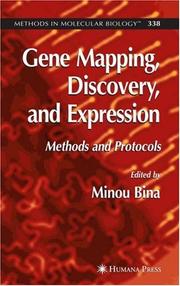
ISBN: 1280832185 9786610832187 1597450979 1588295753 Year: 2006 Publisher: Totowa, NJ : Humana Press : Imprint: Humana,
Abstract | Keywords | Export | Availability | Bookmark
 Loading...
Loading...Choose an application
- Reference Manager
- EndNote
- RefWorks (Direct export to RefWorks)
Completion of the sequence of the human genome and the development of high-throughput technologies have opened a new era of research in biology and medicine. In Gene Mapping, Discovery, and Expression: Methods and Protocols, a panel of researchers from around the world and from a variety of disciplines offer a unique blend of computational tools and experimental techniques for gene mapping, comparative genomics, and studies of the control of gene expression. On the computational side, for beginners in the field, the book describes web-based technologies to localize and map genes, to access and retrieve data from microarray databases, to conduct comparative genomics, and to discover the potential "codes" in genomic DNA that may control the expression of protein-coding genes. Detailed experimental techniques described include methods for studying chromatin structure and allele-specific gene expression, methods for high-throughput analysis and characterization of transcription factor binding elements, and methods for isolation and identification of proteins that interact with DNA. The protocols in the book follow the successful Methods in Molecular Biology™ series format, offering step-by-step instructions, an introduction outlining the principles behind the technique, lists of the necessary equipment and reagents, and tips on troubleshooting and avoiding pitfalls. Cutting-edge and interdisciplinary, Gene Mapping, Discovery, and Expression: Methods and Protocols offers a collection of DNA-sequence-based technologies for gene discovery, retrieval of gene expression data, discovery of regulatory elements, and discovery of transcription factors that interact with DNA.
Biochemistry. --- Cytology. --- Biochemistry, general. --- Cell Biology. --- Cell biology --- Cellular biology --- Biology --- Cells --- Cytologists --- Biological chemistry --- Chemical composition of organisms --- Organisms --- Physiological chemistry --- Chemistry --- Medical sciences --- Composition
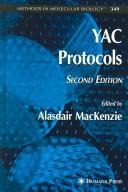
ISBN: 1280832452 9786610832453 1597451584 1588296121 Year: 2006 Publisher: Totowa, NJ : Humana Press : Imprint: Humana,
Abstract | Keywords | Export | Availability | Bookmark
 Loading...
Loading...Choose an application
- Reference Manager
- EndNote
- RefWorks (Direct export to RefWorks)
It is now 10 years since the first edition of YAC Protocols was published in 1996. YAC Protocols was first produced to address the huge demand within the research community for a lab-based text that described in detail the wide range of uses for large insert yeast artificial chromosome (YAC) DNA clones. In doing this, the original editor, David Markie, and the many different contri- tors who provided descriptions of the protocols they used and developed, did a magnificent job. Indeed many of the techniques described within the first e- tion require little change and have stood up admirably to the test of time. Since the first edition, the use of YACs has proved invaluable for addressing a wide range of new biological problems ranging from those of basic biochemistry to assisting in the mapping and sequencing of the human genome. The requirement for a second edition of YAC Protocols was prompted by a number of major advances in biology since the publication of the first edition. These advances have included the sequencing of the human genome, and the genomes of a wide variety of other organisms, and the increased use of transgenic animals for understanding the molecular basis of human and animal disease.
Biochemistry. --- Human genetics. --- Biochemistry, general. --- Human Genetics. --- Genetics --- Heredity, Human --- Human biology --- Physical anthropology --- Biological chemistry --- Chemical composition of organisms --- Organisms --- Physiological chemistry --- Biology --- Chemistry --- Medical sciences --- Composition
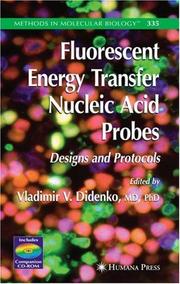
ISBN: 1280832096 9786610832095 1597450693 1588293807 Year: 2006 Publisher: Totowa, NJ : Humana Press : Imprint: Humana,
Abstract | Keywords | Export | Availability | Bookmark
 Loading...
Loading...Choose an application
- Reference Manager
- EndNote
- RefWorks (Direct export to RefWorks)
Although fluorescent probes and assays, which use energy transfer (ET) for monitoring DNA reactions, have multiplied in recent years, until now there have been no manuals summarizing the many different protocols and probe designs. Fluorescent Energy Transfer Nucleic Acid Probes: Designs and Protocols is the first publication to provide such a collection. In the volume, hands-on experts-often the original developers of the technique-comprehensively describe a variety of fluorescent probes and devices that use ET, including molecular beacons, molecular break lights, TaqMan® probes, LUX™ primers, Invader® assay, aptazymes, DNAzymes, molecular machines, biosensors, and logic gates for molecular-scale computation. Merging work on nanotechnology and fluorescent probes, the authors assemble the first comprehensive treatment of all the key DNA- and RNA-based ET probes and present strategies for their optimized custom design. They discuss both fluorescence resonance energy transfer (FRET)-based and non-FRET-based constructs, and provide a complete set of techniques to monitor DNA and RNA reactions, such as hybridization, amplification, cleavage, folding, and associations with proteins, other molecules, and metal ions. Detailed protocols are provided for distance determination in protein-DNA complexes and the detection of topological DNA alterations, mutations, and single-nucleotide polymorphisms. The protocols follow the successful Methods in Molecular Biology™ series format, each offering an outline of the principles behind the technique, step-by-step detailed instructions, and comprehensive troubleshooting. Exhaustive and state-of-the-art, Fluorescent Energy Transfer Nucleic Acid Probes: Designs and Protocols is an invaluable resource for both novice and experienced researchers who wish to use the latest developments in fluorescent probes in any field of molecular biology.
Biochemistry. --- Cytology. --- Biochemistry, general. --- Cell Biology. --- Cell biology --- Cellular biology --- Biology --- Cells --- Cytologists --- Biological chemistry --- Chemical composition of organisms --- Organisms --- Physiological chemistry --- Chemistry --- Medical sciences --- Composition
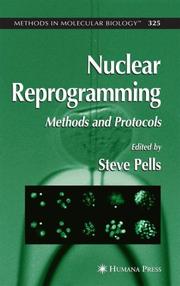
ISBN: 1280358602 9786610358601 1597450057 1588293793 Year: 2006 Publisher: Totowa, NJ : Humana Press : Imprint: Humana,
Abstract | Keywords | Export | Availability | Bookmark
 Loading...
Loading...Choose an application
- Reference Manager
- EndNote
- RefWorks (Direct export to RefWorks)
Although nuclear reprogramming-the cellular process underlying cloning and the artificial generation of stem cells from somatic cells-may be considered a "black box" whose interior events are either completely unknown or at least imperfectly characterized, tantalizing clues about its operation are beginning to emerge. In Nuclear Reprogramming: Methods and Protocols, hands-on laboratory scientists describe readily reproducible methods for actually performing nuclear reprogramming by nuclear transfer in several different species, by fusion induced both chemically and electrically, and by the in vivo treatment of cells with cell extracts. Isolation of an adult stem cell type is also described. In addition, several methods of monitoring nuclear reprogramming are presented, including the use of transgenic markers, activation of telomerase as an ES-specific marker, light and electron microscopic observation of structural changes in the nucleus, and the verification of surface marker expression and differentiation potential of stem cells. Biochemical methods are provided for the examination of chromatin protein modifications, nucleosomal footprinting, transcription factor binding, and the study of DNA methylation changes both at the specific locus level and at the level of the whole nucleus. The protocols follow the successful Methods in Molecular Biology™ series format, each offering step-by-step laboratory instructions, an introduction outlining the principles behind the technique, lists of the necessary equipment and reagents, and tips on troubleshooting and avoiding known pitfalls. Wide-ranging and highly practical, Nuclear Reprogramming: Methods and Protocols significantly expands the repertoire of methods available to perform, study, and understand nuclear programming, not only for cloning, but also for reprogramming somatic cells to stem cells.
Biochemistry. --- Cytology. --- Biochemistry, general. --- Cell Biology. --- Cell biology --- Cellular biology --- Biology --- Cells --- Cytologists --- Biological chemistry --- Chemical composition of organisms --- Organisms --- Physiological chemistry --- Chemistry --- Medical sciences --- Composition
| Listing 1 - 10 of 147 | << page >> |
Sort by
|

 Search
Search Feedback
Feedback About
About Help
Help News
News